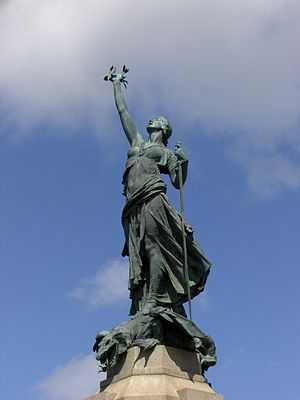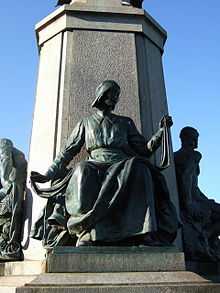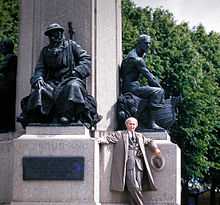Exeter War Memorial
| Exeter War Memorial | |
|---|---|
| United Kingdom | |
 | |
| For World War I World War II Korean War Falklands Conflict Northern Ireland Afghan conflict | |
| Unveiled | 1923 |
| Location | 50°43′35″N 3°31′56″W / 50.7263°N 3.5322°WCoordinates: 50°43′35″N 3°31′56″W / 50.7263°N 3.5322°W |
| Designed by | John Angel (sculptor) |
Total commemorated |
|

Exeter War Memorial, also known as The Northernhay War Memorial is a war memorial in Exeter, Devon, located opposite Rougemont Castle in Northernhay Gardens. Designed by John Angel,[1] it was erected in 1923 at a cost of £6000[2] and supported by public subscription.[3]
History
At the time, John Angel was spending four years as an assistant to Sir George Frampton, and his influence is apparent in the allegorical style.[4][5] The figure of "Peace" (also known as Victory[6]) was exhibited by Angel at The Royal Academy in 1922,[1] being exhibited in the courtyard of Burlington House,[6] as were other studies of this and the Bridgewater War Memorial on several occasions.[4]
An additional plaque honours those soldiers killed in World War II.[7]
Haytor Quarry was reopened in 1919 solely to provide the granite for the memorial.[8] Quarried and erected by Messrs. Easton & Son of Exeter, it is a total of 31 ft (9.4 m) high, with a 20 ft (6.1 m) high pedestal.[2] The figure representing Victory, 8 ft (2.4 m) tall, is said to hold "aloft a spray of laurels in token of gratitude to Heaven. Boldly modelled, and with considerable action, this figure, standing on a dragon, forms an interesting silhouette from all sides."[2] On each of the four arms of the cross is a bronze figure representing the war, including a soldier, a sailor on the hull of a ship, a prisoner of war, and a V.A.D. nurse in uniform holding a bandage.[2] The figures would each be 7 ft 4 in (2.2 m) in height if they were standing.[2] Northernhay contains a history of the Exeter War Memorial.
The dedication ceremony for the memorial was celebrated by the Bishop of Crediton Robert Trefusis. It was unveiled by the Right Honourable Admiral David Beatty. Ceremonies were concluded by a trumpeter on Athelstan's Tower who played The Last Post.[7]
Contemporary events
In November 2010, following the death of Harry Patch, the last English survivor of World War I trench warfare, a ceremony was held at the memorial. City historian Dr. Todd Gray noted that with his death, the time for remembrance had arrived: Now ". . . we are at that point. . . . The city's Great War memorial was created so that future generations would know about the sacrifices men made on their behalf. In the years that have followed this monument and all others have evolved into memorials for all war and I would encourage any Exonian who has a few moments to show their respect."[9] As Dr. Gray observed, this is one of hundreds of World War I memorials scattered around Devon. He believes that even though they are nearly a century old, they are relevant today, as they are community centers for sharing and grief.[10]
On 10 September 2012, a new memorial — to honour those from Exeter who gave their lives since World War II — was dedicated. It is said to be a "complement" to the 1923 memorial.[11] The dedication was hosted by Air Chief Marshall Sir Stuart Peach. The memorial will honour ten Exeter servicemen who "lost their lives in conflicts overseas", including those in Afghanistan, Iraq, and Northern Ireland. Family members of the soldiers were consulted as to its form. Attendees included the Lord Mayor Councillor Rob Newby, the Bishop of Exeter the Rt. Rev. Michael Langrish, and battalion and regimental representatives from the units in which the fallen had served. Mayor Newby stated, "As a city, we already honour our dead from the two Great Wars, and it is fitting that we honour those who have fallen since 1945. This memorial allows us to do just that."[11] The polished granite tablet has a remembrance exhortation and lists ten names. The Exeter City Council commissioned it upon the suggestion of Kirianne Curley, widow of one of the honoured fallen.[12][13] It will continue to be the site of local services on Remembrance Sunday.[13][14] Like the original dedication ceremony, this too concluded with a playing of The Last Post.[15][14]
-

-

-

John Angel at Exeter
See also
References
- ↑ 1.0 1.1 "Sculptor John Angel". Your Archives. Retrieved 8 September 2012.
- ↑ 2.0 2.1 2.2 2.3 2.4 Brine, M.E. (31 July 2009). "EXETER — THE NORTHERNHAY WAR MEMORIAL". Devon Heritage. Retrieved 8 September 2012.
- ↑ buttonpresser. "The Northernhay war memorial, Exeter". Retrieved 8 September 2012.
- ↑ 4.0 4.1 "John Angel". Mapping the Practice and Profession of Sculpture in Britain and Ireland 1851-1951. University of Glasgow History of Art and HATII, online database. 2011. Retrieved 8 September 2012.
- ↑ "John Angel F.R.B.S.". Devon Heritage. Retrieved 6 September 2012.
- ↑ 6.0 6.1 Borg, Alan (1991). War Memorials: From Antiquity to Present. London: Leo Cooper, Ltd. p. 100. ISBN 085052363X. ISBN 9780850523638.
- ↑ 7.0 7.1 "Exeter's Northernhay War Memorial". Exeter Memories. 5 June 2009. Retrieved 9 September 2012.
- ↑ "Granite quarrying and the Haytor Granite Tramway". Dartmoor National Park Authority. Retrieved 19 September 2012.
- ↑ "Todd appeals to public to remember war dead". 13 November 2010. Retrieved 9 September 2012.
- ↑ Laing, Jemima (19 October 2010). "Lest we forget Devon's First World War memorials]". Devon: BBC. Retrieved 9 September 2012.
- ↑ 11.0 11.1 "City to unveil new memorial to soldiers killed in line of duty". Western Morning News (This is Cornwall). 1 September 2012. Retrieved 9 September 2012.
- ↑ "New memorial for war victims". Express & Echo (Exeter: This is Exeter). 6 September 2012. Retrieved 9 September 2012.
- ↑ 13.0 13.1 "New memorial to fallen servicemen in Northernhay Gardens". Express & Echo (Exeter: This is Exeter). 1 September 2012. Retrieved 9 September 2012.
- ↑ 14.0 14.1 "Memorial unveiled to honour city's fallen servicemen". Express & Echo (Exeter: This is Exeter). 11 September 2012. Retrieved 11 September 2012.
- ↑ "New memorial commemorates Exeter fallen since WWII" (video). BBC. 11 September 2012. Retrieved 11 September 2012.
External links
| Wikimedia Commons has media related to Exeter War Memorial. |
- "Exeter War Memorial Unveiled" (video). ITV. 10 September 2012. Retrieved 10 September 2012.